
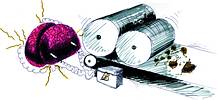
A White paper by Neil Freeman, Jonathan Luse, Anoop Mathur from 7th Canadian Symposium on Mining Automation, Fort McMurray, Alberta, Canada
Part I of this article introduced the special nature of the problems that ore grinding applications are faced with. In Part II, methods of approaching such a control exercise are discussed, introducing Honeywell’s neural network solution.
Traditional PID controls, incorporating cascades and selector switches, have proved to successfully stabilise mill operations. For example, a common approach for control is to cascade the mill load to feedrate. If high power draw may cause mill stoppages, then this must be incorporated into the control scheme by adding an override selector:
This scheme will select either load or power and control this, depending on the situation. In effect, the mill will be under load control for most of the time unless the power exceeds a certain value at which time the selector switch will latch and put the mill under power control. When the power has returned to normal, the switch will return to load control. This control scheme can similarly add other factors such as noise, rate of change, product size and appropriate delay time, etc.
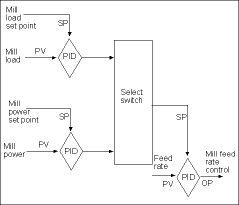
This scheme can very quickly get complex because single input - single output (SISO) building blocks are being used for multi-input - multi-output (MIMO) problems. The main challenge with this scheme is the difficulty in tuning each of these blocks. Each PID block must be tuned individually and any one block, not tuned correctly, can affect the whole control operation.
This classical approach has proved to successfully stabilise mill operations, however; the SISO methodology falls short in a number of areas:
1. Feedback only - PID waits for a problem to actually occur before correcting it.
2. Steady state only - These controllers are configured and tuned to provide good control around the 'normal' operating range, but might not have the right tuning approach when an upset occurs.
3. Constraint handling - The SISO approach by nature only handles one item at a time, and gives no consideration to the variable interactions that occur.
4. Optimisation - SISO controllers use a hard setpoint (ie, control production to 450 tons). It is the operator's duty to push the constraints to maximise the circuit throughput. This can be very difficult if the results of the changes are not understood and further problematic due to the long delay times involved.
The result experienced with many SISO approaches is that operations tend to run the circuit 'safely' and therefore below the maximum possible production.
Advanced controls: TotalPlant SmartGrind technology
It has been found that model based, multivariable control systems can tune, stabilise and optimise the process, but cannot adequately handle fast upsets such as power excursions. They cannot detect ore characteristic changes, like hardness, either. Neural networks, however, are very good at recognising patterns, and can recognise ore changes, predict upcoming spillage and power excursions by identifying the subtle pattern of events that lead up to the excursion. Once such predictions are made, the control scheme can then take safe control action before the excursion occurs.
By using both multivariable control and neural network technology, a control scheme can stabilise the controls, optimise the process, and achieve the financial objectives of 'more tons per hour' and 'less rands per ton'.
Using multivariable control and multivariable predictive control
An operator is often required to concurrently control a number of variables (eg, flows) to achieve multiple targets (throughputs, densities, etc). To do this effectively, the operator must know which variable to change and the impact of each change on the other plant variables. The problem is further complicated by the need to perform changes constantly under varying plant conditions or ore types. As a result the operator tends to not push the plant close enough to its constraints. Instead some margin is left between the operating point and the process limits. Operating at one or more of these limits is very often the most profitable operating point. This 'margin', therefore, equates directly to lost production and profits.
The aim of a multivariable controller (such as Honeywell's Robust Multivariable Predictive Control Technology, RMPCT) is to reduce this margin and its deviation by manipulating multiple process variables continuously and automatically. The controller contains models that predict the relationships between each of the manipulated variables and each target or controlled variable. For example, the expected mill power change resulting from a change in feed rate is modelled. The models are also used to predict and eliminate the interactions between variables.
Costs can be placed against each of the variables and they can indicate which parameters are the most cost effective to change under the current conditions. For example, a reduction in throughput may be more expensive than an increase in cyclone feed density. An optimiser is incorporated into RMPCT to use these costs to determine the most profitable set of variable changes. Hard process limits are placed on each of the variables. These ensure the process does not move into unstable or less profitable operating regions. The optimiser considers these limits when determining the next set of changes. The controller also uses these limits to control the process. If a variable moves outside the limit, the control action is escalated to quickly return the variable into the operating region.
The control action provided by RMPCT allows the plant to be safely operated closer to constraints with less deviation from the target values. The result is an improvement in throughput, quality or some other profit related objective. (This is shown schematically in Figure 2.)
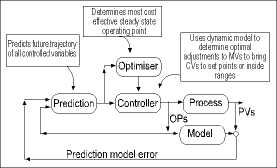
In addition to multivariable control, a model of the process dynamics is incorporated to predict future behaviour of the process and determine how to adjust the controller's outputs in order to bring all process variables to setpoints or within constraints. If there are any degrees of freedom remaining, the controller adjusts the process to optimise operations, for example by maximising throughput. This type of controller is called a multivariable predictive controller (MPC).
MPC (such as the Honeywell's RMPCT) can be viewed as a tool to keep process variables within the specified range or setpoint, just as a collection of single-loop controllers would do except that MPC will do a good job with interacting variables where the collection of single-loop controllers would perform poorly. But often the real value of MPC is that it allows us to consider an entire process as a single entity rather than as a collection of isolated control loops. MPC then becomes a tool to keep the process within operational constraints while optionally optimising some performance measure.
Neural networks and smart modules
Grinding mills such as SAG mills experience power excursion or spillage typically at high throughputs or due to changes in ore type. An MPC configured to operate optimally at a nominal operating point will perform poorly or will not be able to reject a severe disturbance such as an excursion.
Figure 3a shows MPC controlled well through a slow excursion but could not reject the fast excursion fast enough to avoid the maximum constraint violation on power. A neural network can be trained off-line to recognise patterns leading to excursion on-line. The advance information from such a neural network is used to on-line reconfigure the goals of the MPC when the disturbance is predicted.
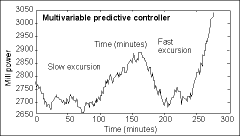
Figure 3b shows performance of the hybrid (neural network and MPC) controller. On this particular day there was very coarse ore going into the mill and there were frequent power excursions. The hybrid controller maintained the power within the specified constraint without any operator intervention. On the left, the neural network shows a 90% correlation (prediction) of a power excursion at time 160, and shows a 100% correlation of a power excursion starting at time 260.
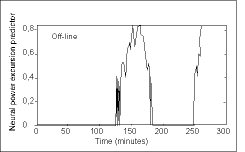
The neural network is a smart module that adjusts the parameters of the MPC to steer the process to avoid reaching some hard constraints only during the disturbance. Thus the controller performance is not compromised during normal operations.
Figure 3c shows how the neural network predicted several impending power excursions. By incorporating this predictor with the robust multivariable predictive controller (RMPCT), it is now possible to control the power draw and maximise throughput by avoiding process upsets.
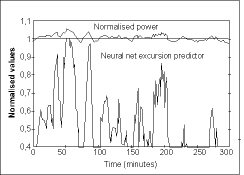
Smart modules such as the neural network predictor can be customised to achieve the best performance for a site under various operating scenarios. On one ball mill site Honeywell developed an ore type indicator to optimise the grind size versus throughput target. On other sites smart modules can detect sensor malfunction and reconfigure the controller goals automatically.
In all cases this powerful combination of MPC and smart module will increase throughput by pushing the plant toward constraints and will reduce variability of product quality such as particle size leading to improved recovery.
The SmartGrind architecture
SmartGrind uses Honeywell's robust multivariable predictive control technology (RMPCT) as the core engine and controller. RMPCT models the process, makes predictions of future process variables, and uses multivariable controls to execute the optimisation. Smart modules and neural networks are added to aid the prediction process and help avoid process upsets. The architecture is shown in Figure 4.
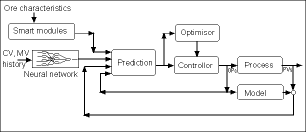
Benefits
Each grinding circuit has its own control issues and objectives. Some are throughput limited, have spillage problems, experience power excursions, or have many types of ore with different optimum load points for each type. These variables can occur individually or together and, because each circuit has different objectives, SmartGrind's benefits will vary from site to site.
To generalise, it is typical to realise at least 2% mill throughput improvement by applying the control scheme discussed in this paper. The throughput improvements might be from an actual new maximum constraint on throughput, a reduction of the standard deviation of average throughput, an avoidance of downtime through stable controls or a combination of all. Furthermore, the tuning and maintenance requirements for traditional controls are alleviated, the difficulty of pushing constraints is made automatic, and the mill operators start operating their grinding circuit with an economic objective rather than to a particular setpoint.
SmartGrind is beneficial to mills that are not throughput limited. By using neural networks and multivariable predictive control schemes, these mills can grind ore to a smaller range of sizes and reduce their overall power consumption, increasing recovery and reducing power costs. Standard deviation of the ore size range can be reduced by 50%, increasing recovery significantly. The flexibility of SmartGrind's smart modules allows the user to customise the application to address their individual needs of the mill.
For more information contact Honeywell SA, 011 695 8000, [email protected].

© Technews Publishing (Pty) Ltd | All Rights Reserved